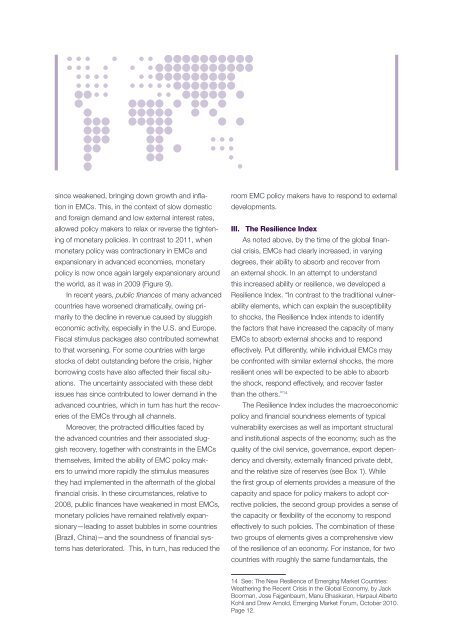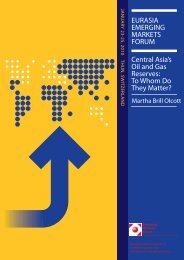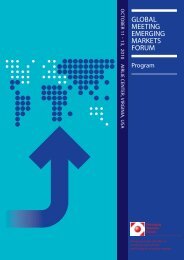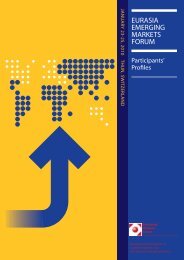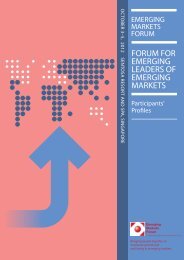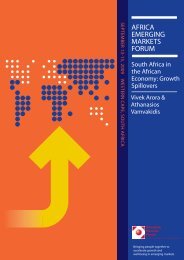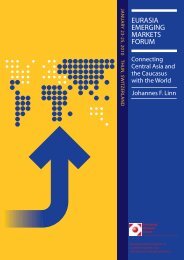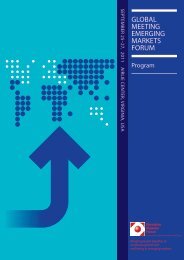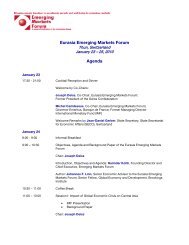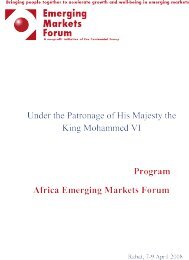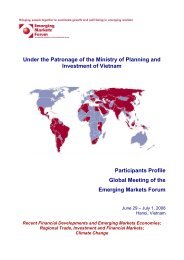The Centennial Resilience Index: Expanding Its Coverage and ...
The Centennial Resilience Index: Expanding Its Coverage and ...
The Centennial Resilience Index: Expanding Its Coverage and ...
Create successful ePaper yourself
Turn your PDF publications into a flip-book with our unique Google optimized e-Paper software.
since weakened, bringing down growth <strong>and</strong> inflationin EMCs. This, in the context of slow domestic<strong>and</strong> foreign dem<strong>and</strong> <strong>and</strong> low external interest rates,allowed policy makers to relax or reverse the tighteningof monetary policies. In contrast to 2011, whenmonetary policy was contractionary in EMCs <strong>and</strong>expansionary in advanced economies, monetarypolicy is now once again largely expansionary aroundthe world, as it was in 2009 (Figure 9).In recent years, public finances of many advancedcountries have worsened dramatically, owing primarilyto the decline in revenue caused by sluggisheconomic activity, especially in the U.S. <strong>and</strong> Europe.Fiscal stimulus packages also contributed somewhatto that worsening. For some countries with largestocks of debt outst<strong>and</strong>ing before the crisis, higherborrowing costs have also affected their fiscal situations.<strong>The</strong> uncertainty associated with these debtissues has since contributed to lower dem<strong>and</strong> in theadvanced countries, which in turn has hurt the recoveriesof the EMCs through all channels.Moreover, the protracted difficulties faced bythe advanced countries <strong>and</strong> their associated sluggishrecovery, together with constraints in the EMCsthemselves, limited the ability of EMC policy makersto unwind more rapidly the stimulus measuresthey had implemented in the aftermath of the globalfinancial crisis. In these circumstances, relative to2008, public finances have weakened in most EMCs,monetary policies have remained relatively expansionary—leadingto asset bubbles in some countries(Brazil, China)—<strong>and</strong> the soundness of financial systemshas deteriorated. This, in turn, has reduced theroom EMC policy makers have to respond to externaldevelopments.III. <strong>The</strong> <strong>Resilience</strong> <strong>Index</strong>As noted above, by the time of the global financialcrisis, EMCs had clearly increased, in varyingdegrees, their ability to absorb <strong>and</strong> recover froman external shock. In an attempt to underst<strong>and</strong>this increased ability or resilience, we developed a<strong>Resilience</strong> <strong>Index</strong>. “In contrast to the traditional vulnerabilityelements, which can explain the susceptibilityto shocks, the <strong>Resilience</strong> <strong>Index</strong> intends to identifythe factors that have increased the capacity of manyEMCs to absorb external shocks <strong>and</strong> to respondeffectively. Put differently, while individual EMCs maybe confronted with similar external shocks, the moreresilient ones will be expected to be able to absorbthe shock, respond effectively, <strong>and</strong> recover fasterthan the others.” 14<strong>The</strong> <strong>Resilience</strong> <strong>Index</strong> includes the macroeconomicpolicy <strong>and</strong> financial soundness elements of typicalvulnerability exercises as well as important structural<strong>and</strong> institutional aspects of the economy, such as thequality of the civil service, governance, export dependency<strong>and</strong> diversity, externally financed private debt,<strong>and</strong> the relative size of reserves (see Box 1). Whilethe first group of elements provides a measure of thecapacity <strong>and</strong> space for policy makers to adopt correctivepolicies, the second group provides a sense ofthe capacity or flexibility of the economy to respondeffectively to such policies. <strong>The</strong> combination of thesetwo groups of elements gives a comprehensive viewof the resilience of an economy. For instance, for twocountries with roughly the same fundamentals, the14 See: <strong>The</strong> New <strong>Resilience</strong> of Emerging Market Countries:Weathering the Recent Crisis in the Global Economy, by JackBoorman, Jose Fajgenbaum, Manu Bhaskaran, Harpaul AlbertoKohli <strong>and</strong> Drew Arnold, Emerging Market Forum, October 2010.Page 12.


